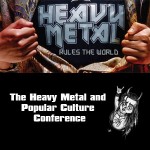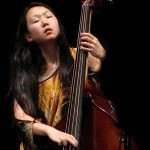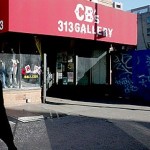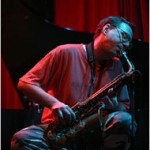 Packing for the 2013 Heavy Metal and Popular Culture conference in Bowling Green, Ohio, the first to be held on U.S. soil, I paused, a button-down shirt in one hand, a Meshuggah shirt in the other, looking back and forth between them, as though I were trying to match socks.
Packing for the 2013 Heavy Metal and Popular Culture conference in Bowling Green, Ohio, the first to be held on U.S. soil, I paused, a button-down shirt in one hand, a Meshuggah shirt in the other, looking back and forth between them, as though I were trying to match socks.
The question of what to wear had never loomed quite so large.
The morning of the first day, my mind was made up for me: I had gone directly from school to Penn Station, to catch the 4 o’clock Lake Shore Limited to Toledo. I was in Bowling Green by 7 a.m. My hotel room wouldn’t be ready for a few hours, so I stowed my bag at the front desk and walked to campus still wearing the clothes I’d taught in the day before: dockers, collared shirt, black dress shoes. It was a chilly morning, the sun just peeking over the rim of the western Ohio plains, wind blustering down the wide flat treeless main thoroughfare. The student union, the hub of conference activities, was at the far end of campus, a mile away.
BGSU is a flagship institution in popular culture studies. It’s still the only place in the U.S. where you can earn a graduate degree in the field, and is home to a renowned library (named after the pop culture department’s founder, Ray Browne) to support research. From the late ‘70s until just last year, the department had resided in a 1932 Sears-designed kit house, the ex-living quarters of four former BGSU presidents. Despite a joint faculty-student effort to save it, the house was bulldozed to make way for a new student health center.
My first impression of the BGSU campus made me nostalgic for the pop culture house, this though I’d only seen it in grainy internet photos. Past the Stroh Center, BGSU’s sports arena, I hooked right into a wasteland of squat brick student barracks; the academic buildings, into whose midst I entered a few minutes later, were hardly more charming. The student union was pretty much what you’d expect: glass and carpet, a cafeteria, chairs fit for dozing …
So I did, and came to a little after eight. A couple of women had appeared, one working at her laptop, dressed like anyone would for an academic conference—suit, spiffy glasses—and another, probably a student, with a purple streak in her hair, peddling logoed totes and guitar picks along with programs and name tags.
Then a third figure appeared, male, wiry and sunchapped, with a long, thin beard and a black cap pulled tightly over his skull, the words VERY METAL written across it. He was the first drop in a deluge: full beards, long hair, earrings, black sweatshirts and trenchcoats, ratty jeans and old sneakers, denim and leather and jean jackets covered with patches … and, of course, black T-shirts with the names of bands on them.
And me? Here I’d had the opportunity to dress for a conference like I would on any other weekend, and I was still in my teaching duds. In my bag at the hotel, one measly Meshuggah shirt. I might at least have pulled it on with the dockers and dress shoes, and made of myself an exquisite corpse.
*
If you think I’m dwelling on something petty or unrelated to this conference, think again. The blurb on the back of the anthology Metal Rules the Globe (Duke UP, 2011), co-edited by conference co-organizer and BGSU professor Jeremy Wallach, calls metal studies “a burgeoning field”; and when fields burgeon, questions of “Who am I? And what do I study?” necessarily raise themselves. What does it mean to be a metal scholar, with each word emphasized in turn? What are the musical and other signifiers around which the four-decade old genre on which we lavish our attention can be said to cohere? To what extent is metal present sheerly in the clothes, images and iconography of the subculture (or scene, or tribe, or taste public, or whatever) built up around the music? Is it possible to imagine the culture without the music—“metal beyond metal,” as someone cleverly put it? How has the subculture changed in its growing diversity over the last two decades, as global cultures transform local ones, and vice-versa, and more women and minorities distinguish themselves and participate at a variety of levels? It is not without meaning (to quote Melville, ever and anon) that the first two people I saw the morning of the first day were women, or that the first male participant I met had traveled all the way from New Zealand. With questions of identity so much at the center of inquiry, a paper examining modes of dress at a metal conference would have fit right in.
Lest you still think I’m making mountains from molehills: Matt Donahue, a local artist and musician who teaches in the pop culture department, has an ongoing “heavy metal T-shirt project.” He’s traveled around the world, stopping at shows and record stores and other hang-out spots, interviewing fans about what their metal shirts mean to them. There was even a room set up at the conference, next to the exhibit on metal masks and facepaint, for attendees to participate. On Friday night he took an hour so to scroll through a few hundred photos and show a couple of vids. In one, a burly bald guy in a tight black T ranted at the camera, boxing: “What, people think I should grow up or somethin’, that I’m some kind of fuckin’ dork ‘cause I wear this shit? This is who I am.”
This is who I am. I am, frankly, less sure about who I am. I identify strongly with the metal community, whatever that is, but can pass as a rumpled academic on weekdays, when my inability to tie a tie and keep my shirts pressed is interpreted as membership in the absent-minded professoriate rather than as metal-bred sartorial disdain. My beard is closely cropped, my hair mostly gone, though long in the back—a mixture of defiance, nostalgia, and disinterest. I have no tattoos (whatever that means anymore), only the superannuated desire to get one. I even took out my earrings for an MRI a few years back and never bothered to put them back in. But on Fridays, look out: I duck into the nearest phonebooth and come out wearing a Mastodon shirt. What on earth can it mean?
And what can it mean for my colleagues at the conference? Many noted they had alternate lives and fields of study: the sociologist who works with the Jewish community in London, the anthropologist who moonlights as a pianist for weddings, the classical musician who just started teaching a course in heavy metal—a one-time fan who, for reasons at once personal, pedagogical, and scholarly, was looking to re-connect. Style of dress hardly revealed one’s field of scholarly expertise—there was an enormous diversity of disciplines and professions represented, as well as nationalities—but it did say worlds about one’s identity, about the force cutting across and uniting all these creeds and approaches, and about what had drawn so many of us to this flat, dusty college town in western Ohio, to burgeon together over bagels and coffee, and to participate in the ongoing, collective fashioning not so much of yet another identity, as a sort of ur-identity: one that would help us find harmony among at least some those we already possessed, and enable us to navigate more confidently between them.
If this “we” has a father, it is Robert Walser, author of the 1993 study Running With the Devil. Word has it that he is a reluctant father—“the bastard father to the thousands of the ugly, criticized, the unwanted,” as Pantera once said—and his no-show for the opening keynote seemed to confirm this. Poor Professor Wallach was left up there doing a softshoe, waiting for Walser to walk down the aisle. Whispers that this was not the first time it had happened. Whispers that he is embarrassed about his status as metal guru.
In hindsight, I think Walser did us a favor. Running With the Devil may indeed be seminal, but the field, like the music, has moved on. God absent, he can be that much more easily reviled, his shrine toppled, even as his absence makes him that much more unassailable. At the conference, Walser was at once the most consistently cited and consistently challenged scholar. The hole he left at the beginning—of the conference, of the field itself—becomes a vacuum which younger scholars rush to fill. His absence forces us to look into that hole, rather than to him, for our identity; to look to the work of a community of scholars, newer stars around whom intellectual work can be organized. Keith Kahn-Harris, Steve Waksman, Kevin Fellezs: all attended, and all spoke; it was like a children’s story where the books in my office had come to life. And how could it possibly be more symbolic than for Niall Scott, a leading figure in the new sub-subfield called Black Metal Theory, to step in and fill Walser’s shoes? Wallach called it an example of heavy metal community, but it could be more appropriately read as a Beowulfian challenge: Who would dare step into Walser’s shoes? Who would dare take his mantle on this first morning? Scott went on to read a draft of a paper he would be presenting in a couple of weeks at another conference. Called “The Blackening of the Green,” it was a dark, poetic, playful, pro-putrefaction manifesto-critique of deep ecology. It made me feel like I was listening to a resurrected George Bataille read “The Solar Anus.” Scott himself exudes a sort of cheerful nihilism, a warm blackness; one of Slayer’s better titles, “Serenity in Murder,” jumps to mind. I don’t think I saw a band logo break the blackness of his attire the whole weekend. He is a sort of essential darkness, the personification of that “abyss-topia” (his term) he invited us to stare into—that void Walser had left us. No surprise that, later in the weekend, he would be elected president of a brand-new International Society for Metal Music Studies.
*
Dad may be deadbeat, but mother Deena (Weinstein, Heavy Metal, 1990) was there in force, all spunk and needles, looking never more the bruja, in leather and the darkest of shades, like a blind biker. During one panel I found myself sitting behind a woman who was wearing black fingernail polish, knitting. It wasn’t Weinstein, but for whatever reason I now connect this image with her.
In Running With the Devil, Walser criticized Weinstein for trying to wear the mask of an objective scholar even though she is clearly a fan. It’s not a bad starting point for thinking more heavily about the role of the metal T-shirt at the conference. What were we, really: fans or scholars? Was this an academic conference or a convention, or some hybrid of the two? (N.B.: This is the only academic conference I have been to where people in the audience who were not fans of the subject felt compelled to identify themselves as such.) Is it only much-disparaged metal, always under the boot of the intelligensia, that suffers from this identity crisis, where “metal scholar” sounds like an oxymoron? Or is it the expertise in one pop-culture artifact—Buffy, metal, etc.—that draws the titters, knowing smiles, and expectations of shoddy work by “scholars” overly invested in their subject of inquiry, clouding the serene waters of academic investigation? The metal T-shirt on the academic body seems to me a cipher for these issues.
Interestingly, what became evident over the course of the weekend at Bowling Green was the extent to which fandom and scholarship can be mutually reinforcing rather than mutually exclusive. Keith Kahn-Harris brought this out most forcefully in his keynote, when he suggested that there are kinds of “embodied knowledge,” ways of knowing through the body, that privilege the thoughtful, self-reflexive participant over the detached observer. This is not to idealize the participant-as-scholar in the place of the observer, but rather to problematize both the observer, who comes with a baggage all his own, and the binary that constructs the two as opposites. I am aware that this is not particularly new; feminists have been muddling the investigation-participation binary for a generation, and anthropology has been enriched by the practice of auto-ethnography, of which there were several interesting examples at the conference (a woman who studied underground metal venues in Leeds in part by recording her experiences as a gendered participant; a fellow traveler with female extreme metal fans in North Carolina (“Blasting Britney on the way to Goatwhore”); a self-described “bogan,” or working-class thrash metal fan from New Zealand, studying his own community). Yet, as fans and scholars, we are still haunted by the question of what it means to be both.
In his work on extreme metal scenes, Kahn-Harris builds on the work of Sarah Thornton to define two different forms of subcultural capital:* mundane and transgressive. The former consists of the “everyday activities that [constitute a] scene …—rehearsing, corresponding, trading, buying CDs”; it is “produced through a sustained investment in the myriad mundane practices through which the scene is produced as collective practice,” and is demonstrated “by knowing the complex histories of the scene and by having heard the music of its vast number of bands” (“‘You Are From Israel,’” MRTG 211-12). Transgressive subcultural capital, on the other hand, “is claimed through a radical individualism … It involves an attempt to be different, to challenge and transgress accepted norms within and beyond the scene …. ‘[G]reat art’ produces forms of capital that can be transferable into and out of other scenes; it is … a particular version of a form of capital that exists wherever artists and other individuals seek to attack taboos and ‘the mainstream.’” (214-15). Working in equilibrium with each other, the two forms of capital help to create a scene that is at once stable and innovative (215-16).
Unlike metal, academia is closely associated with what Pierre Bourdieu calls the “field of power”: the cultural capital it bequeaths is (still supposedly) convertible into economic and other forms of power. A discipline like popular culture studies, however, creates an interesting wrinkle, since it grants symbolic power to a kind of “savoir-faire”—Bourdieu’s term for the display of cultural capital—not convertible into other forms of capital. (E.g., at your college’s fundraising cocktail party, no one is going to give a shit that you know Dennis Stratton was Iron Maiden’s original second guitarist. In fact, it may be a deficit.) Like gender and ethnic studies, pop culture was a one-time academic coup; that it still sits uneasily in the academy is suggested by the aforementioned demolition of the pop culture house, which can be read as an act of disciplinary punishment, a reactionary swing of the wrecking ball back toward a more narrow conception of scholarship. At the same time, pop culture studies—Cultural Studies as a whole, really—has a well-recognized tendency to behave like a music subculture, with its own rock-star profs, theory groupies, hip brands, and so on. (Capital may be accumulated and displayed differently in different fields, but the rule that it must be displayed is field-neutral.)
In this light, rather than imagining academia imports a sanctified objectivity into the degraded fan discourse of a music subculture like heavy metal, it may be more productive to examine what sort of a symbolic economy is constituted when the two come into contact under the aegis of pop culture studies. Among metal scholars, knowledge of genre esoterica may be even more highly valued than in metal subculture per se. In this sense, we are distinguished by the degree of mundane subcultural capital we possess and, in Veblenesque fashion, conspicuously display—although its academic currency is limited to the tiny (but burgeoning!) market represented by the conference.** On the other hand, the many bona fide academic fields represented at the conference, the academic subculture called pop culture studies among them, aligns metal studies with the field of power; imported into metal subculture, the (mundane) capital of academia is transgressive. Knowledge of a variety of theoretical languages, partly field-specific, partly cross-disciplinary; the ability to toss around names of philosophers and critics as easily as those of bands and albums; an openness to diversity in gender and sexual orientation; and a political orientation that puts us rather to the left of the more populist mainstream metalhead—all of these things designate us as interlopers, “part of the scene but not of the scene” (Kahn-Harris 215), bearers of transgressive capital which we flaunt (in the scene proper) to our peril, but which, like good narcissists, we imagine is necessary to its progressive evolution. There was thus a tendency at the conference to see those engaged in metal studies as a sort of scene avant-garde, movers and shakers who, through minority-collective action, could spearhead generic innovation. This is the proper answer to the occasionally-expressed fantasy that the community of scholars gathered in the room was congruent or even identical with heavy metal subculture—a fantasy Weinstein was quick to deflate. The bearers of transgressive subcultural capital are never congruent with the scene; they aspire to make the scene congruent with them, aware of the risks this entails, indeed, thriving on these risks. (Then again, there may be no genre of music better poised for transgressive transformation.)
It might be asked who were the outsiders in Bowling Green, who the insiders: the producers, journalists and musicians, some of whom adopted the conventions of academic discourse for their presentations? or the scholars, some of whom wore metal T-shirts to announce their dual citizenship and difference from the “pure” academics, i.e., the musicologists, literary scholars, and others with only a passing interest in the subculture? Actually, everyone with a stake in the conference was a potential insider, engaged in forging, and being forged into, a new alloy. Between the various disciplines represented and the subculture of heavy metal, itself a heterogenous mix, we were participating in the evolution of a subfield, the construction of a new “insider” identity and discourse—one where the language of the fan subculture does not so much puncture the academic as give it a new (off-) color;§ where Pig Destroyer and Pierre Bourdieu rub shoulders in the same clause; where the grain of our voices whittles them into a new coherence. We were building an altar on which to sacrifice a binary that won’t stay dead.
One more thought: the problem of prestige has as much to do with the newness of the subfield as with its much-disparaged object of study. Rick Wallach, who I believe is still president of the Cormac McCarthy Society, once noted (a little more than a decade ago, I think) that he was writing at a moment when the study of McCarthy’s work was moving from having to legitimize McCarthy’s place in the canon to a time when that position was assumed, and the critic could turn to more purely scholarly investigation. What I find particularly fascinating is that those with a passionate investment in McCarthy’s writing—in other words, fans who also happened to be academics—opened up a door for a wider group of scholars to appropriate and write about his work. Exuberant fandom, then, can be the foundation on which a subfield is constructed. Perhaps all passions are scholarly passions in embryo, and vice-versa.
And in all this, the heavy metal T-shirt? It signified the need to perform the mundane rites of metal subculture in order to assert a particular scholarly identity distinct from the academic mainstream. The black T-shirt hugging the scholar’s body becomes a metaphor for both the embodied-ness of the participant and that body’s sublimation into academic language: the logo at the center, the obligatory blackness surrounding it.
*
For Saturday night the conference organizers put together a show with six Toledo metal bands at a Bowling Green dive bar. I’d already been sneaking downtown during the brief lunch and dinner breaks—the local hippie hangout The Happy Badger and Grounds for Thought café/used bookstore. As it turned out, the campus straddled the wasteland of highway and chain stores on the one side, and the much more charming old part of town on the other, full of colorful houses and a suitably gothic city hall.
At the bar I fell into conversation with a couple of conference folk. It turned out I wasn’t the only one with T-shirts on the brain, and, through feints to a panel on metal and community, we ended up doing quite a bit of wondering aloud about the rites and practices associated with “membership,” and how the T-shirt negotiates status. For example: Is it proper to wear a T-shirt of the band you’re seeing to their show? What limits exist as to what one can wear to a show and still blend in? (This has changed, by the way, as the crowd and bands have aged; you see a lot of pinstripe buttondowns nowadays, as grownup suburban kids go straight from their white-collar jobs to a venue.) Who can actually wear the shirt of the band nobody’s heard of? Who can wear the shirt nobody’s seen of the band everybody’s heard of? And what happens if you think you’re wearing the coolest, oldest, most obscure shirt by band X—call it shirt A—only to find that someone else is wearing a yet older and more obscure shirt of the same band—the dreaded shirt B? What can you do but hang your head, or slink around in the corners, or cross your arms over your chest and try to look natural, or run back to the hotel for another shirt, or something to cover up this one—maybe a dress shirt with the top button undone, so that the black T underneath appears as a sort of inverted priest’s collar? How ostentatious we are! How ruthless! No wonder the brightest among us just arrayed themselves in the purest black, a black into which all logos dissolve(s) and any can be imagined, expressing the essence of metal without recourse to the gladiator-pit of savoir-faire. There is something seductive about this black metal theory stuff indeed.
The point is, no matter how much we stand back and chuckle about it, no matter how much smarter we think we are, we do care about this stuff. We were in Bowling Green because we liked to think about this stuff, too, to be at once inside and out, to toggle between body and mind, to sully each in the other.
The subcultural capital had been flying all weekend, as the BGSU student union was turned into the floor of a metal stock market, scholars’ reputations were ruined in a matter of moments as T-shirt trumped T-shirt, participants were asked whether they had heard of obscure metal bands in far-flung locales, and one keynote speaker, Laina Dawes, confessed to be a “snob” because she was only interested in people who were out regularly supporting their local scenes—no “fair-weather fans” allowed in her pool. She actually had a good reason: as a black woman and a metalhead, her life had been one long battle to defend her identity against, on the one hand, a family and community who wondered why she didn’t listen to “black music,” and on the other a subculture that asked the question posed in the title of her memoir: What Are You Doing Here? (Dawes, as someone cattily noted in the Q&A, had decidedly not dressed metal.) Dawes is just a particularly stark example of what the genre as a whole has faced, and the reason metalheads have worked to carve out an identity against the elite and pop mainstreams. Reaction or no, irony or no, it is sad to think that the only way such an identity can be achieved is by aggressive policing of generic and subcultural boundaries. Are you authentic enough to join our church? Beware of poseurs, of outsiders, of coloreds, of injuns, of girls, of those who would ruin it, of those who aren’t sincere, of those whose love is not true. (The recent phenomenon of pop starlets enamored with Iron Maiden T-shirts almost makes me want to eat my sarcasm.) We’ve begun moving beyond a metal scene that is white, male, and heteronormative; if so, rather than allowing other forms of cultural capital to fill the vacuum—forms which, because they reflect the purported meritocracy of broader capitalist society, are presumed to be natural—perhaps it’s time to start imagining community beyond capital, cultural or otherwise, created by beings who are not inherently “capital-maximizing,” just as we have begun to imagine metal beyond metal.
Not to sound too much the missionary, but what if we envisaged community as an opportunity for inclusion rather than exclusion? A friend of mine, a writer, would always say he “envied me” when I told him I had not read this or that great work of literature. What he envied was my yet-to-come first encounter with a masterpiece. It was a little patronizing, maybe—he is five or six years my senior—but genial. A little more of this attitude in metal might go a long way. Imagine a sixteen-year-old kid surfing the internet, discovering Ride the Lightning for the first time. How can I not envy him (or her)? It is an envy particularly strong because it is mixed with nostalgia.
The easy availability of so much music through the internet—what Kahn-Harris referred to provocatively (and, I think, correctly) as a “crisis of abundance”—and the explosion of subgenres in metal has increased the number of fan positions and identities available. When items were scarce and required effort to obtain, Kahn-Harris noted, the boundaries of scenes were clearer. Today, with minimal interest and leisure time, one can occupy any number of positions along the continuum between a fractured, multiple center and their many peripheries, making the boundary lines much less clear. Simply put, to call oneself a metalhead today is a much more complex proposition than it was twenty-five years ago; and to kvetch about “weekenders” seems out of touch with the myriad other cultures and identities that coalesce around and impinge upon metal in our historical moment. I would guess there is an element of nostalgia here, for a time when scene boundaries were clear and “poseurs,” a word with such a quaint ring, more easily identifiable. Yet, we continue to operate according to this desire to appear insiders, to be in the good graces of our dearly-authentic peers—to have them authenticate us; there is no other way to be sure—to hysterically affirm our insider-ness, our identity, in the face of threats to our egos. All of us float around some mystical generic center, carrying the baggage of a hundred other identities, and of a highly individual archaeology of taste, each of us wearing a mask in the form of a T-shirt that we have spent the better part of our lives and the best part of our selves fashioning.
Anyway, by Saturday night everybody knew everybody, and everybody was dressing down, so to speak. The MLA woman I had seen on the first morning had put on a black leather jacket. The French rock critic, whose plaid shirt had made him look like an indie rocker snuck into the conference to sneer, came in wearing an old grey denim, tattered and faded as a well-loved paperback. Some looked like they had slept in their clothes for the past three days. For others it was the plaids and chamois that had sloughed off, revealing the black metallic skin beneath, at once soft underbelly and magic armor.
After the T-shirt discussion I listened to one of the bands for a while, and then approached another group: two who had presented on gender in extreme metal, and one Canadian musicologist who had analyzed death metal vocals with a computer. The latter pointed to my Meshuggah shirt. Was I into polyrhythms? I told him I was. Did I play drums? Indeed I did; at least, I had used to practice West African patterns with a drummer friend. We brought our beers to the nearest table. He wanted to play polyrhythms with cross-accents. We started with a simple 2 against 3, but entering on opposite beats, in something like the rhythmic corollary to the harmonic concept of imitative polyphony. Then the boyfriend of one of the two women came over. It turned out he was a drummer. She had wanted to go home. Too late, too late. I recommend a shorter leash next time, my dear. Now we were three, and the number of permutations exploded. We did the same exercise, but accenting the different beats on 3, listening to the “center” travel around the table. Then we got more ambitious: 3 against 4, 3 against 5, 7 against 2 and against 4; we started using our glasses, pens, any other objects within our reach to make the cross-accents clearer. We would all get it for a while, but it was hard not to start laughing, particularly when the death-metal analyzer would shout, “Oh my God, this sounds just like fucking Sepultura!” (the Brazilian extreme metal band known for incorporating polyrhythms and other elements of indigenous and Afrodiasporic percussion into their music; see Idelber Avelar, “Otherwise National,” in MRTG for an illuminating discussion). We would fall apart, like overzealous jugglers hurling pins at each other. Then we would decide drinking more might help. We did this until they closed the bar.
Ah, heavy metal community. And it all started with a Meshuggah T-shirt.
*
I’ve only written one properly scholarly article on metal, which started as a talk at the December 2006 MLA convention and was eventually published under the title “Heavy Melville” in Leviathan in 2009 (link at right). When I started researching the paper, I remember being struck by the fact that almost all the articles on heavy metal were at the John Jay library. John Jay is the criminal justice college in CUNY, and almost all the articles were about whether and how heavy metal contributes to social deviance. (Yes, this is partly what prompted me to write “Vermis Odium,” 02.11.13.) There was very little in the databases analyzing heavy metal and culture, or (God forbid) heavy metal as music. The only books I found were Walser’s and Weinstein’s. I somehow missed Harris Berger’s Metal, Rock and Jazz—it would have been enormously helpful in organizing my discussion of heavy metal fan communities—while Glenn Pillsbury’s and Kevin Kahn-Harris’s studies were just on the cusp of publication.
Focused on questions of prestige and aesthetics, “Heavy Melville” represents only about a third of my original argument; the rest, about form and gender, I had to cut for length. Someday, perhaps, they will form part of a book chapter. If they do, I’ll consider myself lucky to be working at a time when there is such a thing as ISMMS, with its on-line scholarly bibliography, a journal in which to publish scholarship (planned for 2014, fingers crossed), and a community of scholars to read and listen to and bounce ideas off of. I’m already happy to know that I’m not the only one who has taken on Walser’s idea that the guitar solo represents “freedom,” or who has been fascinated by the hand gesture I tried to describe in my now three-year-old review of Immortal at the Brooklyn Masonic Temple. (There is a high-profile metal blog called Invisible Oranges, the name drawn from that very gesture.) As for my T-shirt fetishism and missed opportunity to both present and re-present: apparently I’m to get another chance, in Helsinki, in 2015.
I’m already thinking about what to pack.
* Thornton herself builds on Pierre Bourdieu’s concept of cultural capital, that is, capital symbolically understood as a “resource that can be convertible into forms of power in particular settings” (Kahn-Harris 204). The difference between subcultural and cultural capital is that the former does not mirror the dominant position in what Bourdieu calls the field of power, which “represents those forms of capital (economic, educational, and so forth) that have the most currency in society as a whole” (204). Instead, subcultures set up alternative hierarchies where capital is not so easily “convertible into economic capital and to positions within the field of power.” See Kahn-Harris, “ ‘You Are From Israel, and That Is Enough to Hate You Forever’: Racism, Globalization and Play Within the Global Extreme Metal Scene,” Metal Rules the Globe (Duke UP, 2011), ps. 200-226 (particularly 204-218).
** While it would be stretching or even inverting Kahn-Harris’s terms, it is fruitful to imagine the opposite: that the mundane subcultural capital of something like metal is transgressive, and potentially transformative, of academia, and of the contours of the field of power. This is somewhat to put the cart before the horse, since it is the attention of those fields congruent with the field of power that converts once-subcultural capital into cultural and other forms of capital proper. But there is, there must be, a force exerted from below that drives such shifts, when mainstream and high culture fields absorb the creative energy of subcultures, coverting once red-lined cultural property into something that has currency in the field of power, and changing what gets to count as culture. (This is the moment when the college president smiles at you and says, “Dennis Stratton was fine, but he was no Adrian Smith.”)
§ An example: By the time the scholar at the first Friday morning panel on race and gender apologized “for the [mostly racist, homophobic] language” in YouTube comments, the F-bomb had already been dropped a few times the day before. Forty-five minutes later, the last presenter prefaced his paper with the words, “This is the best fuckin’ panel I’ve ever been on.” Laughter and applause from the audience. Truly, it was one of the best fuckin’ panels I’ve had the pleasure of attending.











